Asia · Attractions · Going Out · Myanmar · Regions
Discovering Bagan, Mayanmar
On our journey to pick up the boat at Pakkoku taking us down the Irrawaddy river to Bagan, I asked our guide Wyn about a rather peculiar practice I had noticed with the locals in Myanmar. Every morning they paint their faces with a yellow substance, looking like very poorly applied make up, some add a circle on each cheek, others two broad square brushstrokes and a few cover their whole face. This is not limited to the women, male and female use the dye, young and old, even the toddlers have it smeared on them.
 Apparently, the use of Thanaka is purely cosmetic and unique to the people of Myanmar. It is a paste made from ground bark and sold in shops and markets throughout the country in its raw form of a short but thick branch from the Murraya tree.
An early start on our first morning in Bagan, but the 4:00 AM wake up call was a small inconvenience for what promised to be a highlight not only of Myanmar and South East Asia, but the whole of our 10 month adventure. This was ballooning at dawn over the 3,000 temples and monuments of Bagan.
Apparently, the use of Thanaka is purely cosmetic and unique to the people of Myanmar. It is a paste made from ground bark and sold in shops and markets throughout the country in its raw form of a short but thick branch from the Murraya tree.
An early start on our first morning in Bagan, but the 4:00 AM wake up call was a small inconvenience for what promised to be a highlight not only of Myanmar and South East Asia, but the whole of our 10 month adventure. This was ballooning at dawn over the 3,000 temples and monuments of Bagan.
 Until the 6.8 magnitude earthquake struck in August 2016 the small town of Bagan had over 4,000 monuments in its 42 sq km region. Temples, stupas, libraries, monasteries and ordination halls mainly from the 11th and 12th C. still litter the landscape and horizon of this magical place. So today we were to see those that remain from the air and the ground.
We met with Piers, our pilot for the morning, a frightfully British gentleman from Bristol, who gave up his job as an airline pilot to spend six months a year ballooning guests across Old Bagan. We were joined by couples from Spain, Korea and Russia for breakfast in the field where the balloon was inflated and there was a little nervous laughter around the table.
Until the 6.8 magnitude earthquake struck in August 2016 the small town of Bagan had over 4,000 monuments in its 42 sq km region. Temples, stupas, libraries, monasteries and ordination halls mainly from the 11th and 12th C. still litter the landscape and horizon of this magical place. So today we were to see those that remain from the air and the ground.
We met with Piers, our pilot for the morning, a frightfully British gentleman from Bristol, who gave up his job as an airline pilot to spend six months a year ballooning guests across Old Bagan. We were joined by couples from Spain, Korea and Russia for breakfast in the field where the balloon was inflated and there was a little nervous laughter around the table.
 But once we were in the basket with the flame roaring above our heads as we rose serenely into the brightening sky any apprehensiveness disappeared as quickly as the ground below us.
It was stunning. The morning mist draped itself around the hundreds of temples and across the parched land, as we rose higher the sun broke through to give the scenery below a golden hue and all was quiet.
But once we were in the basket with the flame roaring above our heads as we rose serenely into the brightening sky any apprehensiveness disappeared as quickly as the ground below us.
It was stunning. The morning mist draped itself around the hundreds of temples and across the parched land, as we rose higher the sun broke through to give the scenery below a golden hue and all was quiet.
 A couple of hours later we landed softly on the sandbanks of the broad Irrawaddy river and after a celebratory glass or two of champagne, allegedly an acknowledgement to the French inventors of ballooning, we were collected by boat and taken back to the hotel to start the day with another breakfast. My goodness what fun.
We met Aung our guide for the day, a lawyer and it seemed to me part time political activist who had campaigned hard for UNESCO protection of the area. He was a charming man, keen to debate the difficult issues the country has to address with a joint military and democratic government, but with an infectious giggle and an encyclopedic knowledge of the area and its monuments. I was keen for him to take us off the usual tourist route, he was not going to disappoint.
A couple of hours later we landed softly on the sandbanks of the broad Irrawaddy river and after a celebratory glass or two of champagne, allegedly an acknowledgement to the French inventors of ballooning, we were collected by boat and taken back to the hotel to start the day with another breakfast. My goodness what fun.
We met Aung our guide for the day, a lawyer and it seemed to me part time political activist who had campaigned hard for UNESCO protection of the area. He was a charming man, keen to debate the difficult issues the country has to address with a joint military and democratic government, but with an infectious giggle and an encyclopedic knowledge of the area and its monuments. I was keen for him to take us off the usual tourist route, he was not going to disappoint.
 Aung explained that in 1990 the military forced the whole population of Bagan to move to a new Bagan outside the old city walls. This was only 10,000 people but nevertheless if, like Aung, it’s your home and family then it’s going to be pretty traumatic so they refused to move. The military cut off the water supply, then the electricity, and when that failed they threatened to open fire. Aung, his family and the remaining villagers left to set up home in New Bagan. Old Bagan where all the monuments are located was now deserted.
The military demolished all the shops, homes and town buildings to allow the building of hotels and private residences for the generals. They had taken ownership of potentially one of the most popular tourist destinations in the world and were not going to let UNESCO interfere, they now charge overseas visitors 25,000 Kyat, about £13, to enter the Bagan Architectural Zone. It is rigidly policed – “show your prepaid card for the officer inspects in any time, the Culture Zone”, as it clearly states on the pass.
We visited the huge gold Shwezigon Pagoda built in the 11th C. as the prototype for all the stupa in the region. The building needs new gold gilt every six years costing $900,000 each time. Below the gleaming structure we found a room around five metres square and ankle deep in money, the notes were being counted and bundled by three kneeling women who couldn’t keep up with the bucket loads being thrown onto the floor by the men.
Aung explained that in 1990 the military forced the whole population of Bagan to move to a new Bagan outside the old city walls. This was only 10,000 people but nevertheless if, like Aung, it’s your home and family then it’s going to be pretty traumatic so they refused to move. The military cut off the water supply, then the electricity, and when that failed they threatened to open fire. Aung, his family and the remaining villagers left to set up home in New Bagan. Old Bagan where all the monuments are located was now deserted.
The military demolished all the shops, homes and town buildings to allow the building of hotels and private residences for the generals. They had taken ownership of potentially one of the most popular tourist destinations in the world and were not going to let UNESCO interfere, they now charge overseas visitors 25,000 Kyat, about £13, to enter the Bagan Architectural Zone. It is rigidly policed – “show your prepaid card for the officer inspects in any time, the Culture Zone”, as it clearly states on the pass.
We visited the huge gold Shwezigon Pagoda built in the 11th C. as the prototype for all the stupa in the region. The building needs new gold gilt every six years costing $900,000 each time. Below the gleaming structure we found a room around five metres square and ankle deep in money, the notes were being counted and bundled by three kneeling women who couldn’t keep up with the bucket loads being thrown onto the floor by the men.
 Maybe there’s not that much difference to the tall hand painted donation thermometers we see at home in the UK outside churches that need a new roof but the opulence and poverty in Myanmar do not sit comfortably together for me.
We mounted our scooters and hit a dusty trail that Aung promised was off the beaten track of tourists. After twenty minutes or so, with our eyes streaming and noses full of grime we arrived at what appeared to be a deserted orange brick temple about thirty feet square with the upturned bell like spire balanced on the roof. It looked neglected but in fairly good condition having escaped the effects of the earthquake.
Maybe there’s not that much difference to the tall hand painted donation thermometers we see at home in the UK outside churches that need a new roof but the opulence and poverty in Myanmar do not sit comfortably together for me.
We mounted our scooters and hit a dusty trail that Aung promised was off the beaten track of tourists. After twenty minutes or so, with our eyes streaming and noses full of grime we arrived at what appeared to be a deserted orange brick temple about thirty feet square with the upturned bell like spire balanced on the roof. It looked neglected but in fairly good condition having escaped the effects of the earthquake.
 Disappointingly the entrance was sealed by a wrought iron gate with a huge padlock, we peered through the bars into the darkness within.
‘In here is my favourite Buddha,’ said Aung.
‘We can’t see anything, Aung,’ said Helene, ‘Are there any lights?’
As the three of us squinted into the musty smelling entrance there was a sharp clanking sound making all three of us jump, it was quite eerie in this isolated spot. A small man appeared out of the darkness removing a large ring of keys from the waist of his longyi.
There were no lights inside the temple but as we found our way around the perimeter wall we entered a room with natural sunlight pouring in from three high openings in the walls above us. They were clearly strategically placed, for they shed a stream of light on the most beautiful seated Buddha we had seen.
Disappointingly the entrance was sealed by a wrought iron gate with a huge padlock, we peered through the bars into the darkness within.
‘In here is my favourite Buddha,’ said Aung.
‘We can’t see anything, Aung,’ said Helene, ‘Are there any lights?’
As the three of us squinted into the musty smelling entrance there was a sharp clanking sound making all three of us jump, it was quite eerie in this isolated spot. A small man appeared out of the darkness removing a large ring of keys from the waist of his longyi.
There were no lights inside the temple but as we found our way around the perimeter wall we entered a room with natural sunlight pouring in from three high openings in the walls above us. They were clearly strategically placed, for they shed a stream of light on the most beautiful seated Buddha we had seen.
 In the gloom and the shadow that surrounded him his pale face shone with red lips and dark eyes looking down on us in a small smile. The remainder of his terracotta coloured body was swathed in a painted vermilion robe leaving one arm bare and hands in the enlightenment mudra position. It was elegant, dignified and stunningly beautiful.
‘You can keep all the gold stupas,’ said Helene, ‘this is by far the most exquisite of them all.’
Of course, she was right.
David Moore is Author of ‘Turning Left Around the World’. Published by Mirador and available from Amazon, it is an entertaining account of David and his wife’s travel adventures – often intriguing, frequently funny and occasionally tragic.
If you would like to be a guest blogger on A Luxury Travel Blog in order to raise your profile, please contact us.
In the gloom and the shadow that surrounded him his pale face shone with red lips and dark eyes looking down on us in a small smile. The remainder of his terracotta coloured body was swathed in a painted vermilion robe leaving one arm bare and hands in the enlightenment mudra position. It was elegant, dignified and stunningly beautiful.
‘You can keep all the gold stupas,’ said Helene, ‘this is by far the most exquisite of them all.’
Of course, she was right.
David Moore is Author of ‘Turning Left Around the World’. Published by Mirador and available from Amazon, it is an entertaining account of David and his wife’s travel adventures – often intriguing, frequently funny and occasionally tragic.
If you would like to be a guest blogger on A Luxury Travel Blog in order to raise your profile, please contact us.
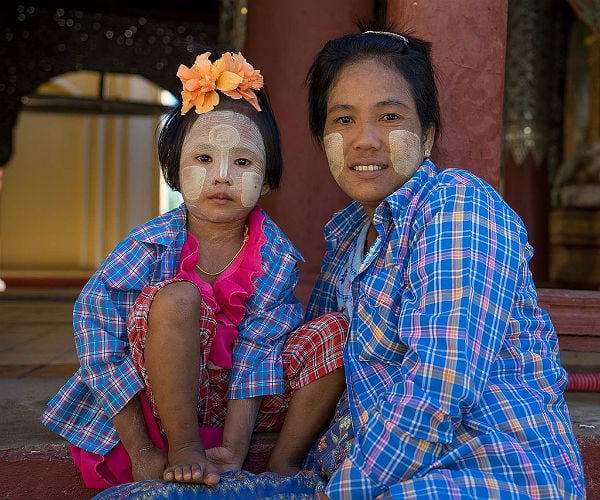 Apparently, the use of Thanaka is purely cosmetic and unique to the people of Myanmar. It is a paste made from ground bark and sold in shops and markets throughout the country in its raw form of a short but thick branch from the Murraya tree.
An early start on our first morning in Bagan, but the 4:00 AM wake up call was a small inconvenience for what promised to be a highlight not only of Myanmar and South East Asia, but the whole of our 10 month adventure. This was ballooning at dawn over the 3,000 temples and monuments of Bagan.
Apparently, the use of Thanaka is purely cosmetic and unique to the people of Myanmar. It is a paste made from ground bark and sold in shops and markets throughout the country in its raw form of a short but thick branch from the Murraya tree.
An early start on our first morning in Bagan, but the 4:00 AM wake up call was a small inconvenience for what promised to be a highlight not only of Myanmar and South East Asia, but the whole of our 10 month adventure. This was ballooning at dawn over the 3,000 temples and monuments of Bagan.
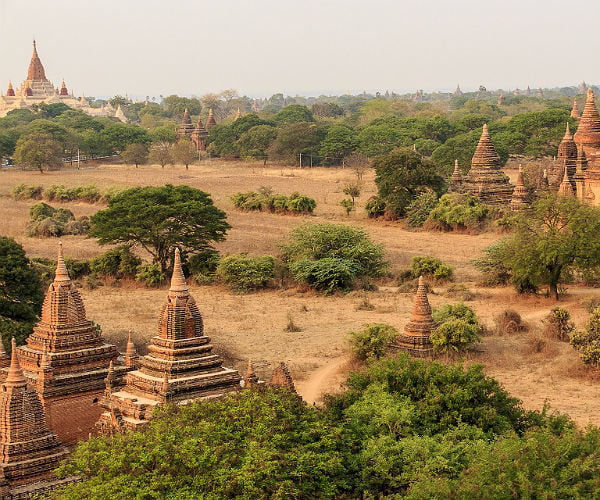 Until the 6.8 magnitude earthquake struck in August 2016 the small town of Bagan had over 4,000 monuments in its 42 sq km region. Temples, stupas, libraries, monasteries and ordination halls mainly from the 11th and 12th C. still litter the landscape and horizon of this magical place. So today we were to see those that remain from the air and the ground.
We met with Piers, our pilot for the morning, a frightfully British gentleman from Bristol, who gave up his job as an airline pilot to spend six months a year ballooning guests across Old Bagan. We were joined by couples from Spain, Korea and Russia for breakfast in the field where the balloon was inflated and there was a little nervous laughter around the table.
Until the 6.8 magnitude earthquake struck in August 2016 the small town of Bagan had over 4,000 monuments in its 42 sq km region. Temples, stupas, libraries, monasteries and ordination halls mainly from the 11th and 12th C. still litter the landscape and horizon of this magical place. So today we were to see those that remain from the air and the ground.
We met with Piers, our pilot for the morning, a frightfully British gentleman from Bristol, who gave up his job as an airline pilot to spend six months a year ballooning guests across Old Bagan. We were joined by couples from Spain, Korea and Russia for breakfast in the field where the balloon was inflated and there was a little nervous laughter around the table.
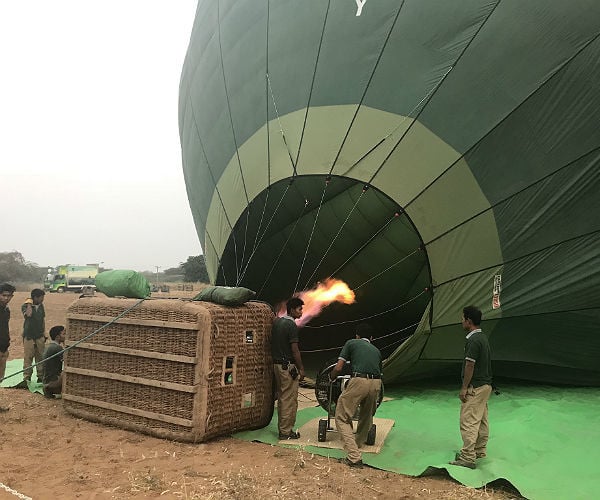 But once we were in the basket with the flame roaring above our heads as we rose serenely into the brightening sky any apprehensiveness disappeared as quickly as the ground below us.
It was stunning. The morning mist draped itself around the hundreds of temples and across the parched land, as we rose higher the sun broke through to give the scenery below a golden hue and all was quiet.
But once we were in the basket with the flame roaring above our heads as we rose serenely into the brightening sky any apprehensiveness disappeared as quickly as the ground below us.
It was stunning. The morning mist draped itself around the hundreds of temples and across the parched land, as we rose higher the sun broke through to give the scenery below a golden hue and all was quiet.
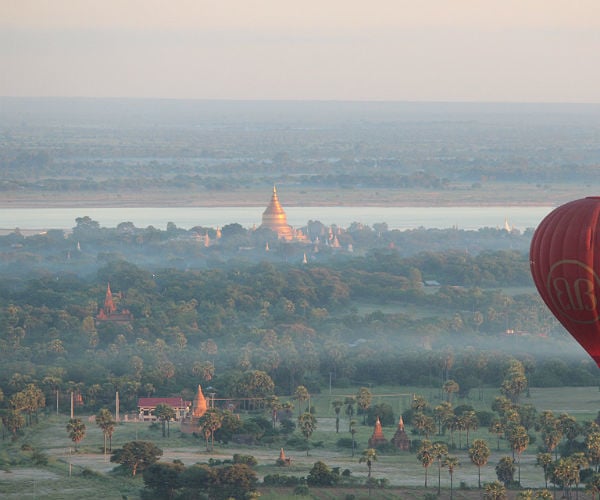 A couple of hours later we landed softly on the sandbanks of the broad Irrawaddy river and after a celebratory glass or two of champagne, allegedly an acknowledgement to the French inventors of ballooning, we were collected by boat and taken back to the hotel to start the day with another breakfast. My goodness what fun.
We met Aung our guide for the day, a lawyer and it seemed to me part time political activist who had campaigned hard for UNESCO protection of the area. He was a charming man, keen to debate the difficult issues the country has to address with a joint military and democratic government, but with an infectious giggle and an encyclopedic knowledge of the area and its monuments. I was keen for him to take us off the usual tourist route, he was not going to disappoint.
A couple of hours later we landed softly on the sandbanks of the broad Irrawaddy river and after a celebratory glass or two of champagne, allegedly an acknowledgement to the French inventors of ballooning, we were collected by boat and taken back to the hotel to start the day with another breakfast. My goodness what fun.
We met Aung our guide for the day, a lawyer and it seemed to me part time political activist who had campaigned hard for UNESCO protection of the area. He was a charming man, keen to debate the difficult issues the country has to address with a joint military and democratic government, but with an infectious giggle and an encyclopedic knowledge of the area and its monuments. I was keen for him to take us off the usual tourist route, he was not going to disappoint.
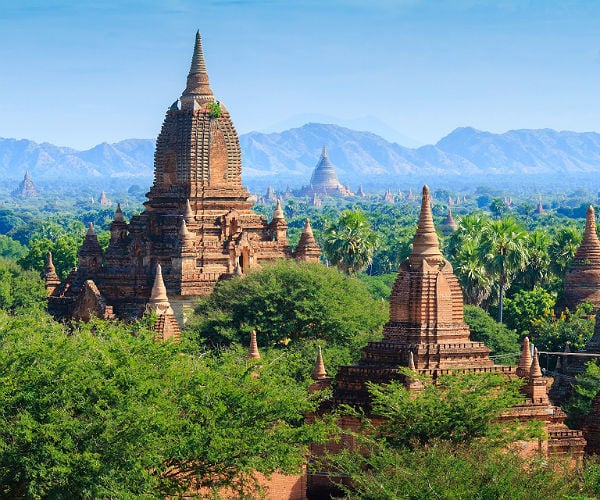 Aung explained that in 1990 the military forced the whole population of Bagan to move to a new Bagan outside the old city walls. This was only 10,000 people but nevertheless if, like Aung, it’s your home and family then it’s going to be pretty traumatic so they refused to move. The military cut off the water supply, then the electricity, and when that failed they threatened to open fire. Aung, his family and the remaining villagers left to set up home in New Bagan. Old Bagan where all the monuments are located was now deserted.
The military demolished all the shops, homes and town buildings to allow the building of hotels and private residences for the generals. They had taken ownership of potentially one of the most popular tourist destinations in the world and were not going to let UNESCO interfere, they now charge overseas visitors 25,000 Kyat, about £13, to enter the Bagan Architectural Zone. It is rigidly policed – “show your prepaid card for the officer inspects in any time, the Culture Zone”, as it clearly states on the pass.
We visited the huge gold Shwezigon Pagoda built in the 11th C. as the prototype for all the stupa in the region. The building needs new gold gilt every six years costing $900,000 each time. Below the gleaming structure we found a room around five metres square and ankle deep in money, the notes were being counted and bundled by three kneeling women who couldn’t keep up with the bucket loads being thrown onto the floor by the men.
Aung explained that in 1990 the military forced the whole population of Bagan to move to a new Bagan outside the old city walls. This was only 10,000 people but nevertheless if, like Aung, it’s your home and family then it’s going to be pretty traumatic so they refused to move. The military cut off the water supply, then the electricity, and when that failed they threatened to open fire. Aung, his family and the remaining villagers left to set up home in New Bagan. Old Bagan where all the monuments are located was now deserted.
The military demolished all the shops, homes and town buildings to allow the building of hotels and private residences for the generals. They had taken ownership of potentially one of the most popular tourist destinations in the world and were not going to let UNESCO interfere, they now charge overseas visitors 25,000 Kyat, about £13, to enter the Bagan Architectural Zone. It is rigidly policed – “show your prepaid card for the officer inspects in any time, the Culture Zone”, as it clearly states on the pass.
We visited the huge gold Shwezigon Pagoda built in the 11th C. as the prototype for all the stupa in the region. The building needs new gold gilt every six years costing $900,000 each time. Below the gleaming structure we found a room around five metres square and ankle deep in money, the notes were being counted and bundled by three kneeling women who couldn’t keep up with the bucket loads being thrown onto the floor by the men.
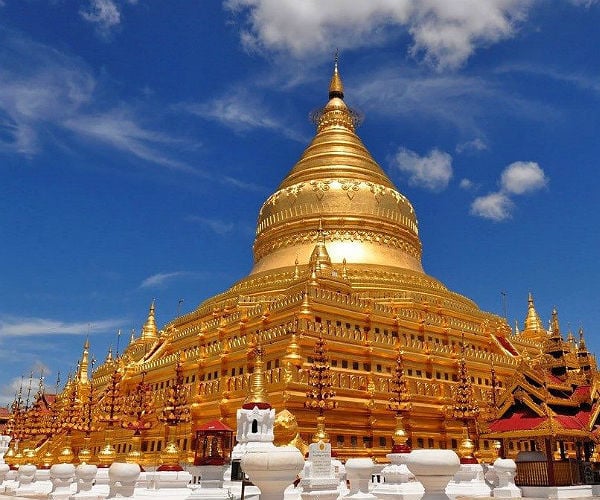 Maybe there’s not that much difference to the tall hand painted donation thermometers we see at home in the UK outside churches that need a new roof but the opulence and poverty in Myanmar do not sit comfortably together for me.
We mounted our scooters and hit a dusty trail that Aung promised was off the beaten track of tourists. After twenty minutes or so, with our eyes streaming and noses full of grime we arrived at what appeared to be a deserted orange brick temple about thirty feet square with the upturned bell like spire balanced on the roof. It looked neglected but in fairly good condition having escaped the effects of the earthquake.
Maybe there’s not that much difference to the tall hand painted donation thermometers we see at home in the UK outside churches that need a new roof but the opulence and poverty in Myanmar do not sit comfortably together for me.
We mounted our scooters and hit a dusty trail that Aung promised was off the beaten track of tourists. After twenty minutes or so, with our eyes streaming and noses full of grime we arrived at what appeared to be a deserted orange brick temple about thirty feet square with the upturned bell like spire balanced on the roof. It looked neglected but in fairly good condition having escaped the effects of the earthquake.
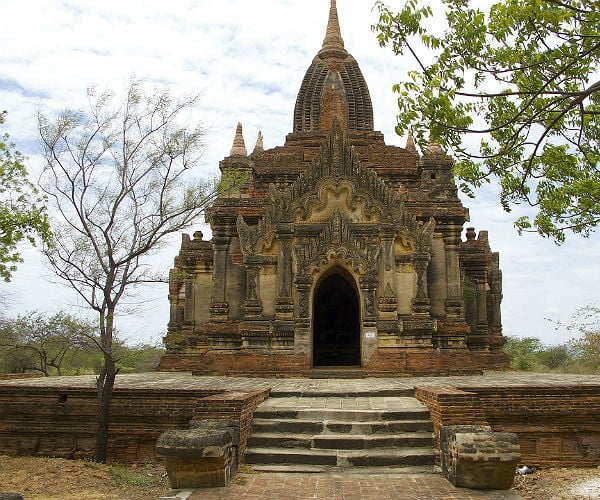 Disappointingly the entrance was sealed by a wrought iron gate with a huge padlock, we peered through the bars into the darkness within.
‘In here is my favourite Buddha,’ said Aung.
‘We can’t see anything, Aung,’ said Helene, ‘Are there any lights?’
As the three of us squinted into the musty smelling entrance there was a sharp clanking sound making all three of us jump, it was quite eerie in this isolated spot. A small man appeared out of the darkness removing a large ring of keys from the waist of his longyi.
There were no lights inside the temple but as we found our way around the perimeter wall we entered a room with natural sunlight pouring in from three high openings in the walls above us. They were clearly strategically placed, for they shed a stream of light on the most beautiful seated Buddha we had seen.
Disappointingly the entrance was sealed by a wrought iron gate with a huge padlock, we peered through the bars into the darkness within.
‘In here is my favourite Buddha,’ said Aung.
‘We can’t see anything, Aung,’ said Helene, ‘Are there any lights?’
As the three of us squinted into the musty smelling entrance there was a sharp clanking sound making all three of us jump, it was quite eerie in this isolated spot. A small man appeared out of the darkness removing a large ring of keys from the waist of his longyi.
There were no lights inside the temple but as we found our way around the perimeter wall we entered a room with natural sunlight pouring in from three high openings in the walls above us. They were clearly strategically placed, for they shed a stream of light on the most beautiful seated Buddha we had seen.
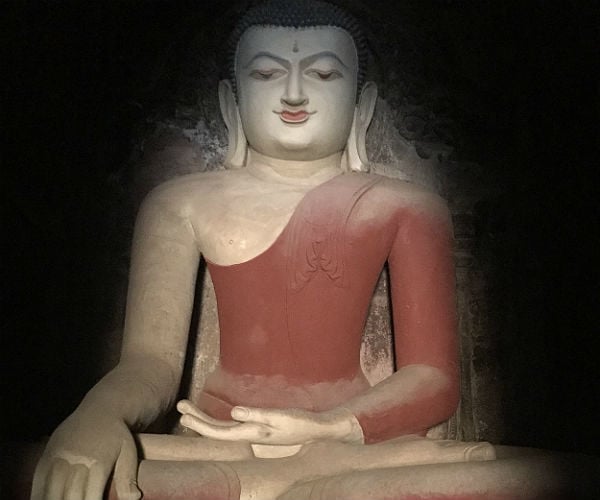 In the gloom and the shadow that surrounded him his pale face shone with red lips and dark eyes looking down on us in a small smile. The remainder of his terracotta coloured body was swathed in a painted vermilion robe leaving one arm bare and hands in the enlightenment mudra position. It was elegant, dignified and stunningly beautiful.
‘You can keep all the gold stupas,’ said Helene, ‘this is by far the most exquisite of them all.’
Of course, she was right.
David Moore is Author of ‘Turning Left Around the World’. Published by Mirador and available from Amazon, it is an entertaining account of David and his wife’s travel adventures – often intriguing, frequently funny and occasionally tragic.
If you would like to be a guest blogger on A Luxury Travel Blog in order to raise your profile, please contact us.
In the gloom and the shadow that surrounded him his pale face shone with red lips and dark eyes looking down on us in a small smile. The remainder of his terracotta coloured body was swathed in a painted vermilion robe leaving one arm bare and hands in the enlightenment mudra position. It was elegant, dignified and stunningly beautiful.
‘You can keep all the gold stupas,’ said Helene, ‘this is by far the most exquisite of them all.’
Of course, she was right.
David Moore is Author of ‘Turning Left Around the World’. Published by Mirador and available from Amazon, it is an entertaining account of David and his wife’s travel adventures – often intriguing, frequently funny and occasionally tragic.
If you would like to be a guest blogger on A Luxury Travel Blog in order to raise your profile, please contact us.Did you enjoy this article?
Receive similar content direct to your inbox.


Meeting people like Piers, the “frightfully English gentleman” is one of the great joys of travel. I find it really so inspiring that so many people fall in love with a part of the world and make the brave decision to relocate. Though in Piers’ case he seems to be making the best of two worlds, earning a reasonable income as a pilot for half the year and then following his passion for the rest of the year.
And to think that I was feeling down because I’ve just paid $2,000 to have the downstairs of my house decorated. Paying $900,000 for gold gilt every six years puts my decorating costs in a new light. I can’t remember when I last had it all decorated!
I just don’t get the yellow blotches. I know you are saying it’s cosmetic but to me it doesn’t look very attractive. I suppose it’s one of those cultural things that those of us from the First World just aren’t going to get. For us putting on make-up has become like a fine art with hours spent watching blogs and mags etc.
Thanaks is not cosmetic. It’s used to deflect mosquitoes which carry malaria.
It’s claimed that it’s used to prevent malaria, leprosy and other ailments but to the best of my knowledge, there is no evidence that exists to endorse (or indeed to refute) any of its traditional medicinal uses. I think there was once some talk of combining it with DEET to protect pregnant women from contracting malaria, but I haven’t heard how far that went.
4.00 am start? This is the price that you sometimes have to pay to see the world’s wonders. I just can’t understand travellers who stay in bed. If all they want to do is sleep then they could have stayed at home and saved their money to do that.
I was on a safari and some of the guests didn’t even make it for the start of some of the early morning game drives.
Great travel writing
1. Makes me feel as if I’m there
2. Makes me want to go and buy a plane ticket right now
I was thinking the same thing, especially when I got toward the end of the post. It was very engrossing and I’ll be checking out his book too!
I think the story of the dark locked gate just sums up travel for me. One moment everything is darkness and disappointment. Then moments later you are in a magical golden scene with the Buddha lit by sunlight. That’s why so many of us have the travel bug, you just don’t know what’s round the next corner.
This all sounds very exotic and far away from me. I mean, I grew up in a city with tall, glass-walled buildings, malls, and air-conditioning. Seeing all this though, is tickling my wanderlust for something different. Mayanmar seems overflowing with culture and you can see how unique it is. You can see every bit of history they had just by looking at their way of life, in the temples that are still standing up until this day, and the way they show how they practice their religion. Everything they have is extraordinary.
The earthquake in 2016 sounds terrifying. I checked Mr Google and he says that’s only 0.1 point off a ‘major’ earthquake on the scale. Mother Nature can be incredibly destructive, but it’s fascinating to be able to see what remains in that area. I wonder if Piers continued doing tours after his 6 months of ballooning travellers in Old Bagan? It’s really interesting to learn the history of Bagan, old and new, like with the military forcing the whole population to move outside the old city walls. I little knowledge of these sorts of events, but I knew of the military taking command, I just didn’t realise the full extent of it. What an amazing adventure!
I’ve travelled a lot and come across many Buddhas all over the globe. I was going to say “in all shapes and sizes” then I realised that most of the statues are basically Buddha shaped but there is still a huge amount of variety in the way the Buddhas are presented as this post shows.
Maybe David, that could be your next book, a picture book of Buddhas from across the planet. I suspect that every Buddha reveals a lot about the aspirations of the people who placed him there.